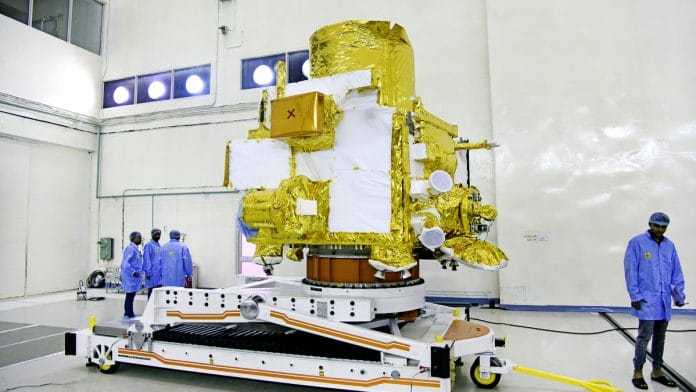Bengaluru: At 2:51 am Monday, 15 July, India will launch its second mission to the moon, Chandrayaan-2, using the heavy lift launch vehicle GSLV Mk III. The mission will consist of an orbiter, a stationary lander and a moving rover. The lander is scheduled to touchdown on the south pole of the moon — a place previously unexplored by any other country — in early September.
Till now only US, Russia and China have landed rovers on the Moon but none have gone in the uncharted south polar region.
Launcher GSLV Mk III has been indigenously built and is India’s largest, most powerful rocket till date. It had previously successfully placed a GSAT-19 communications satellite – the heaviest payload ever launched by India. Nicknamed Fat Boy and Bahubali, it is also slated to be the rocket for ISRO’s ambitious Gaganyaan mission to send humans into space.
The Rs 603 crore Chandrayaan-2 project will be India’s first planetary mission to be led by two women — the project director is design engineer Vanitha Muthayaa and mission director is Ritu Karidhal, formerly the deputy operations director of Mars Orbiter Mission.
Also read: Check out India’s biggest indigenous rocket as ISRO readies for Chandrayaan 2 launch
What is Chandrayaan-2 all about?
Chandrayaan-2, meaning ‘lunar vehicle’, is India’s second mission to the moon that is being launched 11 years after Chandrayaan-1.
The historic Chandrayaan mission, launched in 2008, had sent a probe instrument – Moon Impact Probe (MIP) – to strike the surface of the Moon following which water ice was discovered in the lunar South Pole. While the mission lost contact with Earth a year later (subsequently rediscovered in the orbit 10 years later), the findings drew attention of several countries to the Moon again.
While Chandrayaan-1 only had an orbiter, the new mission also has a lander and a rover, apart from the orbiter.
Orbiter: The orbiter will revolve around the Moon at a circular orbit of 100 km from its surface. It will carry eight payloads, including various types of spectrometers to map minerals and water on the Moon’s surface, read composition of its atmosphere and map the terrain.
Lander: Chandrayaan’s lander ‘Vikram’ will detach from the orbiter on a scheduled day and perform a ‘soft landing’ on the Moon’s surface. It will carry four Indian payloads to study the lunar surface, moonquakes, and its atmosphere, as well as a NASA payload to perform precise measurements of the Earth-Moon distance. It will function near the South Pole of the Moon.
Rover: The rover, called Pragyaan, will first descend from the orbiter on a ramp before moving on to the Moon’s surface. Six-wheeled and an artificial intelligence-powered vehicle, it will travel a distance of 500m. It will contain two payloads – to analyse chemical composition of lunar dust and relay information back to the lander.
The touchdown on lunar surface is expected to take place on 6 or 7 September. Upon touchdown, the rover is expected to send back photographs of its surroundings.
The Moon is exposed to immense solar radiation due to lack of atmosphere and because of this the circuits of Vikram and Pragyaan will burn every day. The lander and the rover, hence, will have lifespans of 14-15 Earth days, while the orbiter is expected to function for over a year.
What’s special about the South Pole?
The lunar South Pole is much like the Earth and covered with water ice throughout the year. But it is filled with craters of various sizes. Sunlight has never entered in several parts of these craters, making them perfect prehistoric freezers to contain clues about the history of the early solar system.
The South Pole is also one of the largest known impact craters in the solar system. The Moon’s surface here is thinner and could contain components from the lunar mantle. The surface geology here is expected to be very different from the rest of the Moon.
What’s special about the GSLV Mk III?
The rocket is India’s biggest and most powerful launcher. It is also the heaviest and capable of transporting much bigger, more precious, and heavier payloads — such as humans — into space.
But the rocket still isn’t powerful enough to carry the spacecraft all the way to the moon like the Saturn V did with NASA’s Apollo missions. Instead, the spacecraft will perform orbit raising manoeuvres around the Earth before flying towards the Moon. Once at the Moon, it will again perform orbit lowering manoeuvres.
Chandrayaan-1 too had performed a similar journey to the moon.
Also read: All set for Moon mission, ISRO unveils images of Chandrayaan 2 lander, rover, orbiter






